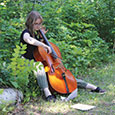Flutists often lament the effects of playing piccolo, saying that it is just too different from the flute, and that it ruins their flute tone. There are indeed differences between the two instruments, and learning to switch comfortably between the two takes time. When I was in graduate school at Carnegie Mellon, a colleague of mine asked Rhian Kenny, of the Pittsburgh Symphony, how to play the piccolo. Her response was memorable in its simplicity, “It’s just like the flute.” This is also true. Many great piccolo players started as, and continue to be, wonderful flutists, and many great flutists have a semi-secret talent for the piccolo. Specializing in or favoring one instrument need not preclude us from enjoying the unique challenges and pleasures of the other. Indeed, in today’s musical climate, it is essential to be able to do as many things well as possible. Understanding the many areas of overlap, as well as the differences, can help players ease the transition from one instrument to the other.
Technique
The piccolo is perhaps most like the flute in technique, except for a few crucial fingerings. Most young flutists do not realize that the optional top octave G# fingering on the flute (No thumb, 0234/0234) is standard for the top octave G# on the piccolo. The long Bb fingering (T100/1004) should be avoided on the piccolo except in extremely fast technical passages where using the lever or thumb is too cumbersome. Because of slight design modifications on the piccolo’s right-hand key work, these fingerings are preferred to correct the intonation.
Depending on whether the piccolo has a split E mechanism or not, there are several flute trill fingerings that may not work as well on the piccolo. While there are a variety of alternate fingerings for both flute and piccolo, the use of alternate fingerings to assist with intonation and tone color is more prevalent when playing the piccolo.
Including the standard fingering, I regularly use one of four fingerings for playing the second octave B pianissimo on the piccolo. Another piccolo player might choose another set of fingerings depending on the intonation tendencies of the particular instrument. (A web search will provide a list of various fingerings. Then choose the ones that work best on your instrument.)
Construction
Depending on the type, design, and materials used to make the piccolo, an instrument may be very similar to or very different from a particular flute. Most professional piccolos are made of wood, with a conical bore and no lip plate on the headjoint. These design modifications make the sound and scale more flute-like and blendable. A metal piccolo produces a sound that is often too strident to blend well with the other winds, and loses the woody warmth that is found on a flute. However, metal instruments are often easier for beginners, and are ideal for use in marching band.
Due to its tiny size, piccolos are constructed in two pieces, and the elimination of the footjoint means that the lowest note is D, although some makers are exploring the design possibilities of a piccolo with a low C#, C, and B. Generally speaking, the key design is mostly the same, except that there are a few keys which can be manually operated independently on a flute that cannot be separated on a piccolo, particularly in the right hand and the G key. This has an effect on trill options and alternate fingerings, but it is rarely an issue in my experience. Many options that have become standard on the flute, like split-E and C# trill, are being included or explored for the piccolo as well.
Scale
The primary intonation difference between flute and piccolo is degree. Since piccolos play at the top of the orchestral range, pitch problems that occur in the lowest notes of the orchestra are amplified in the piccolo register; a piccolo player must be able to resolve seemingly gruesome intonation issues with very small, carefully controlled adjustments.
By and large, flute intonation tendencies apply to piccolo as well, but every piccolo player should examine the full range of the instrument noticing discrepancies. For example, in my flute studies, my teachers emphasized the need to darken the color and lower the pitch on C5 and C#5. However, on piccolo these notes (C6 and C#6) are so flexible that a similar adjustment will make these notes too low. While the high register of a flute is often sharp, I sometimes have to bring the top octave G up slightly on the piccolo. As you explore piccolo playing, use a tuner to make a pitch tendency chart for both your flute and piccolo and compare the similarities and the differences.
Tone Production
Sometimes flutists assume tone production on piccolo is vastly different from flute. It is not different at all. It simply comes down to a concept of sound, and listening for that sound. Problems arise when flutists assume tone production is different, so they produce a different tone. The same methods you apply to get a full, resonant, pure, polished, lush, warm, dark, sparkling (insert your favorite adjective) tone on flute can and should be applied to piccolo, albeit with an ear for the appropriate size.
It is like painting with a thick paintbrush versus a narrow one, and the paint is the air. Strive for the same quality of a free, supported airstream and utilize the complete physical resonance of the body so that the tone is produced before it comes out of the piccolo. When the tone exits through the opening in the lips, it is adapted to fit the instrument – that is, channeled efficiently through the smaller aperture, and shaped to create that concept of sound in a way that suits the musical situation.
Vibrato
As the piccolo sounds an octave higher than written, when playing piccolo, use vibrato appropriate to the note that is sounding, not the note you see. This means you should think of the vibrato as being faster and narrower than the vibrato would be if you were reading the same note on the flute. As you ascend through the range of the piccolo, vibrato will get narrower yet. Even in very soloistic passages, the high register on piccolo should never have a wide, throbbing vibrato. At that frequency, such pulsations will sound like wild variations in pitch rather than a beautiful expressive tool. Like the flute, vibrato should always exist within the sound. Do not use a vibrato that overwhelms the tonal resonance of a given pitch.
Endurance
In order to play piccolo well, you should become comfortable playing at the top of its range. For hearing safety, wear an earplug or two when practicing. You will get used to the sound of the register, but it is essential to be mindful of long-term hearing, and the highest decibel ranges of the piccolo can be damaging. Play with confidence and do not shy away from high notes. Any issues of lip fatigue, buzzing, or breath control can probably be solved by taking a break, or playing the same passage on flute and trying to learn from your familiarity with the other instrument. Do not expect to master the differences in a matter of days or even weeks. Sporadic marathon piccolo practice sessions are ill-advised if you have not trained appropriately. Instead, play the piccolo a little bit every day. It is the top register of the flute, and there is truly wonderful music written for it. You cannot reach those musical highs without it.
.jpg)






